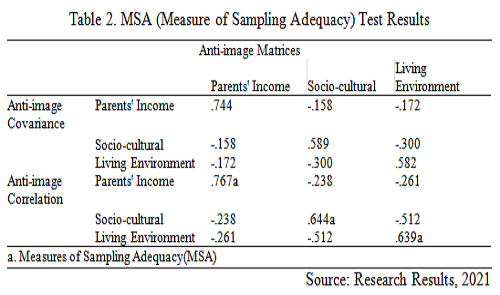
Parental Income, Socio-Cultural, and Living Environment as Factors Causing Children to Drop Out of Middle School in Rengat Barat District
Abstract
Keywords
Full Text:
PDFReferences
Aristin, N. F. (2015). Faktor- Faktor yang Berpengaruh terhadap Anak Putus Sekolah Tingkat Sekolah Menengah Pertama (SMP) di Kecamatan Bondowoso. Jurnal Pendidikan Geografi. 20(1).
Bagoe, R. (2013). Faktor-Faktor Penyebab Anak Putus Sekolah di Desa Suka Damai Kecamatan Bulango Utara Kabupaten Bone Bolango. Skripsi, 1(221408062).
Baningsih, N., & Nuranisa, D. W. (2020). Analisis Penyebab Anak Putus Sekolah di Desa Sri Agung Kecamatan Banyuasin II Ditinjau Secara Geografis. Jurnal Swarnabhumi Vol, 5(1).
Bonaldo, L., & Pereira, L. N. (2016). Dropout: Demographic profile of Brazilian university students. Procedia-Social and behavioral sciences, 228, 138-143.
Fahmi, M., & Marizkaa, D. (2014). Analisis Karakteristik Anak Tidak Bersekolah di Indonesia. Characteristics Analysis of Out of School Children in Indonesia. Jurnal Ekonomi dan Pembangunan Indonesa. 14(2).
Imron, A. (2015). Manajemen Peserta Didik Berbasis Sekolah. Jakarta: Bumi Aksara.
Kamsihyati, S., Sutomo, S., & Suwarno, S. (2017). Kajian faktor-faktor penyebab anak putus sekolah di Desa Jangrana Kecamatan Kesugihan Kabupaten Cilacap. Geo Edukasi, 5(1).
Lockett, C., & Cornelious, L. (2015). Factors Contributing to Secondary School Dropouts in an Urban School District. Journal Research in Higer Education, 29.
Mahmuddin, M., Halimah, S., & Wardania, W. (2019). Penyebab Anak Putus Sekolah di Desa Tumbang Kaminting Kecamatan Bukit Santuai. Jurnal Paedagogie Media Kependidikan, Keilmuan dan Keagamaan, 7(1), 25-30.
Mishra, P. J., & Azeez, A. (2014). Family Etiology of School Dropouts: A Psychosocial Study. International Journal of Multidisciplinary Approach and Studies, 1(5), 136-146.
Mua, V. B., & Manginsela, E. P. (2017). Faktor-Faktor Penyebab Putus Sekolah Dari Anak Petani Dan Non-Petani Di Desa Sea Dan Desa Warembungan Kecamatan Pineleng Kabupaten Minahasa. Agri-Sosioekonomi, 13(3A), 313-322.
Mudyahardjo, R. (2016). Pengantar Pendidikan. PT Grafindo. Jakarta.
Peraturan Pemerintah Republik Indonesia Nomor 47 Tahun 2008 Tentang Wajib Belajar. Jakarta: Mendiknas.
Setiawan, R., Hasyim, A., & Yanzi, H. (2013). Faktor-faktor yang Menyebabkan Remaja Desa Tidak Melanjutkan Pendidikan Kejenjang Sekolah Lanjutan. Jurnal Kultur Demokrasi, 2(2).
Shahidul, S. M., & Karim, A. H. M. Z. (2015). Factors Contributing to School Dropout Among The Girls: A Review Of Literature. European Journal of research and reflection in educational sciences, 3(2).
Soares, T. M., Fernandes, N. D. S., Nóbrega, M. C., & Nicolella, A. C. (2015). Factors Associated with Dropout Rates in Public Secondary Education in Minas Geraisl. Educação e Pesquisa, 41, 757-772.
Sugiyono. (2015). Metode penelitian Kuantitatif, kualitatif dan kombinasi (Mixed Metode), Bandung: Alfabeta.
Undang-Undang Republik Indonesia No. 20 Tahun 2003 Tentang Sisdiknas. Bandung: Citra Umbara, 2006.
Ungureanu, R. (2017). School Dropouts – A Theoretical Framework. International Journal of research in engineering and social sciences, 7(1), 21-27.
Wahab, R. (2015). Psikologi Belajar. Jakarta: Rajawali Pers.
Zainuri, M., Matsum, J. H., & Thomas, Y. (2014). Tingkat Pendapatan, Sosial Budaya dan Jarak Rumah dengan Sekolah sebagai Faktor Penyebab Anak Putus Sekolah di SMPN. Jurnal Pendidikan dan Pembelajaran Khatulistiwa, 3(10).
DOI: http://dx.doi.org/10.31258/jes.6.1.p.56-65
Refbacks
Copyright (c) 2022 DESY HARYANI.Z

This work is licensed under a Creative Commons Attribution 4.0 International License.
Publisher: FKIP Universitas Riau












